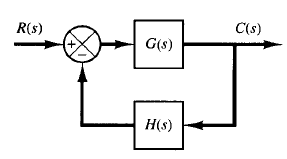SKEDSOFT
General rules for constructing root loci
For a complicated system with many open-loop poles and zeros, constructing a root locus plot may seem complicated, but actually it is not difficult if the rules for constructing the root loci are applied.

Fig: 1 Control system
The general rules and procedure for constructing the root loci of the system shown in Figure 1.
First, obtain the characteristic equation

Then rearrange this equation so that the parameter of interest appears as the multiplying factor in the form

We assume that the parameter of interest is the gain K, where K> O. (If K < 0, which corresponds to the positive-feedback case, the angle condition must be modified.) Note, however, that the method is still applicable to systems with parameters of interest other than gain.
1. Locate the poles and zeros of G(s)H(s) on the s plane. The root-locus branches start from open-loop poles and terminate at zeros (finite zeros or zeros at infinity). From the factored form of the open-loop transfer function, locate the open-loop poles and zeros in the s plane. [Note that the open-loop zeros are the zeros of G(s)H(s), while the closed-loop zeros consist of the zeros of G(s) and the poles of H(s).]
Note that the root loci are symmetrical about the real axis of the s plane, because the complex poles and complex zeros occur only in conjugate pairs.
Find the starting points and terminating points of the root loci and find also the number of separate root loci. The points on the root loci corresponding to K = 0 are open loop poles.This can be seen from the magnitude condition by letting K approach zero, or

This last equation implies that as K is decreased the value of s must approach one of the open-loop poles. Each root locus thus originates at a pole of the open-loop transfer function G(s)H(s). As K is increased to infinity, each root-locus approaches either a zero of the open-loop transfer function or infinity in the complex plane. This can be seen as follows: If we let K approach infinity in the magnitude condition, then
